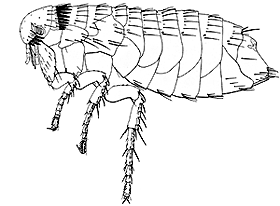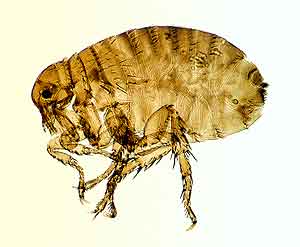|
Siphonaptera:
fleas
Characteristics
Fleas
are small, wingless insects ranging in size from approximately 1-10
millimetres in length depending on the species. Almost everybody,
especially those with cats or dogs will be familiar with these small
biting insects and will have either seen them or the effects of
their nuisance bites. Fleas can be recognised by the following features:
 Ctenocephalides
felis (PULICIDAE)
Ctenocephalides
felis (PULICIDAE) |
|
- Laterally
compressed bodies
- Piercing-sucking
mouthparts
- Enlarged
hind legs adapted for jumping
- Strong tarsal
claws adapted for holding onto their hosts
- Backward
pointing hairs and bristles for ease of movement through the hair
of a host
- Small antennae
which tuck away into special groves in the head
The species
Ctenocephalides felis (above) is the introduced cat flea
but can survive on a wide range of host species. The larvae
of all fleas appear grub-like and are usually found in the nests
of their host or other areas where they commonly rest.
Life Cycle
Fleas
mate on their host animal and lay their eggs either onto the animal
where they fall to the nest or directly in the nest. The small larvae
hatch from the eggs and do not begin to feed on blood like that
of their parents but consume the dead skin and other dirt and dust
from the host animal. The larvae
develop through 3 instars
and when fully grown spin a silken cocoon
and pupate
in the nest of the host. The vibrations of a host often trigger
the emergence of the adult flea from the pupal case, enabling it
to immediately find a host and begin feeding. The complete life cycle may take from several
weeks to many months depending on the species.
|

Pulex irritans (human flea)
|
Feeding
Adult
fleas feed on the blood of their host and although most fleas are
adapted to one particular animal, many are not host specific and
will move to other animals if their preferred host is unavailable.
Fleas are very adaptable and are also able to withstand unfavourable
conditions and can live for many days without food.
Habitat
Fleas are always found close by their hosts, either in direct contact
such as among the feathers or hair or within their nests. Fleas
are found in almost all habitats in Australia where there is a ready
host and many native species of flea are closely associated with
native marsupials and rodents. The main introduced species are also
associated with animals that have been introduced to the country
such as the cat flea (Ctenocephalides felis) the dog flea
(Ctenocephalides canis) and the rat flea (Xenopsylla cheopis).
|


